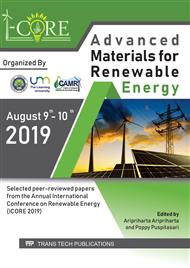p.3
p.9
p.16
p.25
p.32
p.38
p.47
p.53
p.61
Fabrication of Bilayer Fe2O3/ZnO Photoanode and its Photoelectrochemical Performance
Abstract:
Hematite (Fe2O3) is one of the abundant magnetic materials in nature. Hematite has good absorption ability in the region visible light and good electrochemical stability, which make this material is potential as photoanode for photoelectrochemical (PEC) cells. However, Fe2O3 has some disadvantages such as short hole diffusion length and low hole mobility. Therfore, it is necessarily to combine Fe2O3 with photocatalyst material to improve photoelectrochemical performances. ZnO is ones of photocatalist material with good electron mobility, wide band gaps, cheap and are easily fabricated. The aim of this study is to investigate the performance of bilayer Fe2O3/ZnO as photoanode for photoelectrochemical cell. The bilayer Fe2O3/ZnO was prepared by spin-coating techniques and doctor blade methods. The samples were characterized by X-ray diffarction, and Scanning Electron Microscopy. The performance of photoelectrochemical cell was investigated by Cyclic Voltammetry (CV) under light illumination. The result indicate that bilayer Fe2O3/ZnO has good photoelectrochemical properties.
Info:
Periodical:
Pages:
32-37
Citation:
Online since:
July 2020
Keywords:
Price:
Сopyright:
© 2020 Trans Tech Publications Ltd. All Rights Reserved
Share:
Citation:


